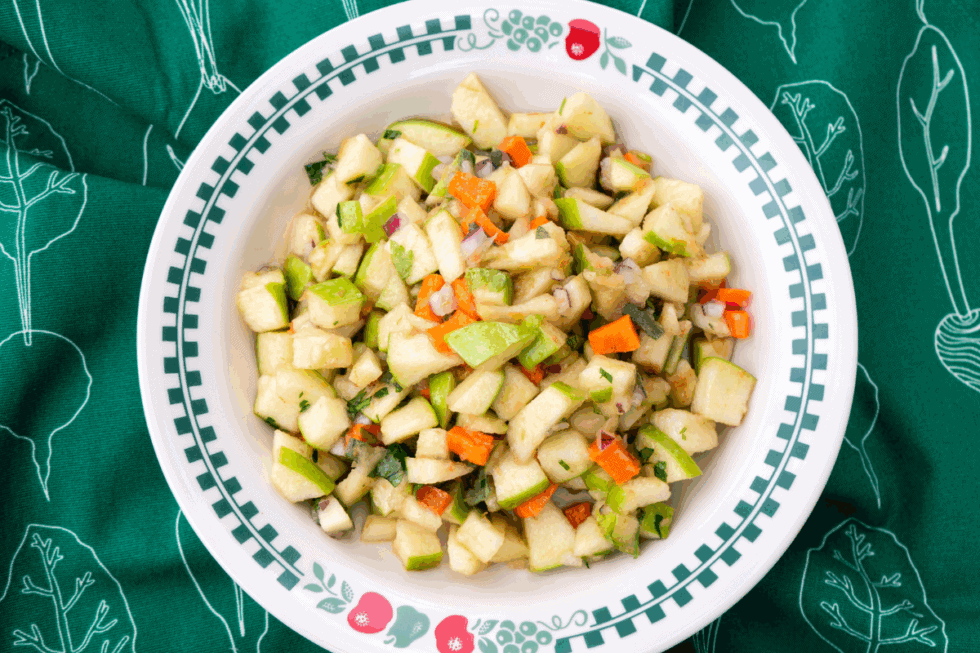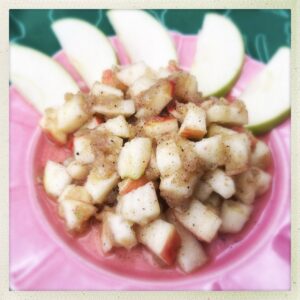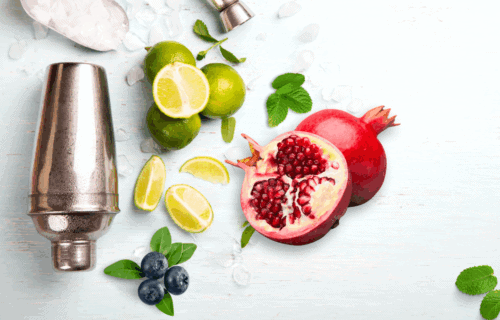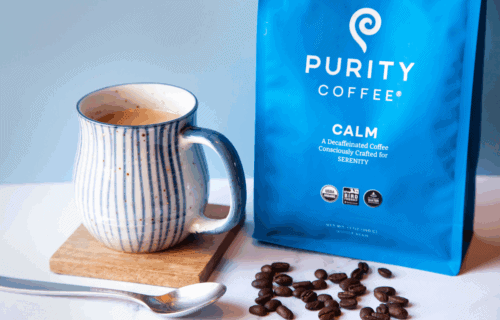
Low Histamine Apple Salsa 2 Ways (also Low Lectin and Low Oxalate)
Enjoy low histamine apple salsa 2 ways — sweet or savory.
This versatile snack recipe can be enjoyed on its own, or you can refresh your go-to low histamine recipes using these salsas as condiments.
Sweet Honeycrisp apples plus vanilla, ginger and fresh pear puree make up our sweet salsa.
And tart Granny Smith apples with pear puree and carrots, red onion, sage, parsley, and olive oil makes a savory salsa reminiscent of a hearty autumn meal.
Get the recipes below!
You’ll get the recipes and learn about:
- 2 big health benefits of apples for Histamine Intolerance and Mast Cell Activation Syndrome.
- Serving suggestions for low histamine apple salsa
- The link to our low histamine chips recipe
This recipe is:
- Low histamine
- Low oxalate
- Low lectin
- Dairy free
- Gluten free
- Vegetarian
Let’s get started!
Before you change your diet on your own, please make sure you’re working with a healthcare practitioner who can help you with this. Never limit foods unnecessarily, and always have a licensed medical provider who is supervising your case.
Low Histamine Apple Salsa
What comes to mind when you think of salsa?
The tomato-based condiment you eat with chips or on a taco?
Nothing quite compares to a tomato. Especially one fresh from a summer garden.
But you’ll see that tomatoes fall under the high histamine category on the low histamine foods list.
When it comes to replacing tomatoes in recipes, you often need to think outside the box.
We’ve used tart and sweet cherries, cranberries, as well as other fruits and veggies in recipes that would normally call for tomatoes.
For this recipe, we used apples.
We know that apples aren’t really a close substitute for tomatoes. But creative thinking keeps your food possibilities open.
Apples have great versatility when it comes to flavor. You can get everything from tart Granny Smiths to super sweet Red Delicious.
In our savory salsa option, we used Granny Smiths for their crispness and tartness.
For our sweet option, we used Honeycrisp apples. We like the sweetness and crispness of these apples.
Pink Lady or Fuji apples would also work for the sweet salsa option.
Red Delicious are on the softer side. Some people find them a little mealy.
But Red Delicious, when peeled, are the lowest in salicylates.
Different apple varieties have different nutritional profiles.
But most apples have similar benefits when it comes to:
- High fiber content
- Polyphenols
Fiber
Apples have both soluble and insoluble fiber. Both are good for your gut health.
Soluble fiber absorbs water and makes stool easier to pass. This is good for those with constipation.
Insoluble fiber does not dissolve in water, adding bulk to stool. This is good for those with diarrhea.
These gut issues are common symptoms of Mast Cell Activation Syndrome and Histamine Intolerance.
Another benefit of dietary fiber is that it leads to the production of short-chain fatty acids.
Short chain fatty acids (SCFAs) help lower inflammation, also making them beneficial if you have Mast Cell Activation Syndrome and Histamine Intolerance.
And like dietary fiber, SCFAs can aid in gut health.
Better gut health equals a happier nervous system and happier mast cells.
Fiber is very good for your body!
Polyphenols
Polyphenols are plant compounds that act as antioxidants in the body.
Antioxidants protect cells and tissues from damage caused by free radicals.
Free radicals are unstable molecules. And without getting too deep into the science of free radicals, here’s what to ultimately know relating to Mast Cell Activation Syndrome.
Free radicals can trigger mast cell activation. They can also damage cells and interfere with cell functioning.
Antioxidants such as polyphenols help to stabilize free radicals.
Apples have several types of polyphenols that act as antioxidants. Including quercetin.
In addition to antioxidant properties, quercetin has been shown to have:
- Anti-inflammatory properties
- Antiviral activities
- Immunomodulatory properties (helps with immune health / immune support)
Fiber and polyphenols are good reasons to add apples to your diet.
And this craveable apple salsa recipe will make it easy to do!
Here are a few ideas for how to eat apple salsa.
Serving Suggestions
Our chunky apple salsas can be enjoyed in a number of ways.
Here are just a few ideas to get you started.
PS: If you like your salsa a little less chunky, feel free to blend up more of the apple.
PPS: We didn’t add sweetener to the sweet salsa. We thought the apple and pear were sweet enough. However, if your sweet tooth is strong, feel free to add a few drops of stevia.
Cassava Tortilla Chips
Chips and salsa might be at the top of the list when it comes to craveable snacks.
You’ll start with our low histamine cassava tortilla recipe and from there, you can broil, bake, or use your air fryer to make chips. Exact instructions for the 3 ways you can make cassava chips are in the notes section of that recipe.
You can also find directions for the cassava tortilla chips in our mango salsa recipe. (Yeah, we really love salsa around here.) It’s very easy!
Crackers
We have several low histamine cracker recipes that would be good topped with salsa.
Try the cassava herb crackers.
Or the lower oxalate flax seed crackers.
Both recipes can be adjusted to your taste in terms of what herbs and seasonings you use.
We also have a different garlic flax cracker in our snack mix recipe. Super easy and customizable, too.
You can use low histamine crackers as a “chip”.
For a fun variation, add nut butter to your crackers with the sweet salsa for a take on a nut butter and jelly “sandwich”!
Want something a little lighter?
Try fresh veggies.
Veggies
For the savory salsa, you can’t go wrong with fresh veggies and a good crudité platter!
Any combo of low histamine veggies can be dipped in salsa.
We recently started making jicama “crackers”.
Jicama is a crunchy vegetable that can be eaten raw.
When sliced thinly using a mandolin, they make nice “crackers” without having to bake anything. Quick and easy!
Both sweet and savory salsas can also be enjoyed with fresh apple slices for even more apple goodness.
Salsa as a Topping
Salsa makes a good condiment for almost anything.
And with both a sweet and savory option, the possibilities are even greater.
The savory salsa would be tasty on:
- Low Histamine Tacos
- Low Histamine Chicken
- Butter Boards
- A Turkey Dinner Plate – served warm as a gluten free dressing
The sweet salsa would be great with:
- Ice Cream
- Apple Chips
However you eat it, we know you’re going to love it!
Let us know in the comments how you ate your low histamine apple salsa!
Try Low Histamine Apple Salsa With
- Low FODMAP Tacos – Low Histamine, Low Oxalate, Low Lectin, with Low Salicylate Option
- Ghee or Butter Board Recipe – Low Histamine, Low Oxalate, Low Lectin, with Low Salicylate Option
- Cassava Tortillas – Low Histamine, Medium Oxalate, Low Lectin

Low Histamine Apple Salsa 2 Ways
Equipment
- Sharp Knife
Ingredients
Savory Option
- 1 Pear
- 2 Organic Green Granny Smith Apples divided
- 4 Tablespoons Carrot diced (about half a carrot)
- 4 Tablespoons Red Onion diced
- 2 Tablespoons Fresh Sage
- 2 Tablespoons Fresh Organic Flat Leaf Parsley
- 2 Tablespoons Kasandrino’s Olive Oil
- ¼ teaspoon Redmond Real Salt
Sweet Option
- 1 Pear
- 2 Organic Honeycrisp Apples divided
- ½ teaspoon Ginger grated
- ¼ teaspoon Raw Vanilla Bean Powder
- ⅛ teaspoon Redmond Real Salt
Instructions
For the savory option:
- Core your pear and apples.
- Rough chop the pear and ½ of one apple and add both rough chopped fruits to a blender with a teaspoon of water. Blend until smooth.
- Dice the remaining 1 ½ apples. Dice the carrot. Dice the red onion. Add these ingredients to a large bowl and add in the pureed fruit.
- Chop the sage and parsley and add to the mixture.
- Finish by adding salt and olive oil. Toss to combine all ingredients.
For the sweet option:
- Core your pear and apples.
- Rough chop the pear and ½ of an apple and add to a blender with a teaspoon of water. Blend until smooth.
- Dice the remaining 1 ½ apples.
- Grate the ginger.
- Add the apples and ginger to a large bowl and add the pureed fruit.
- Add the vanilla powder and salt. Toss well to combine all ingredients.
Notes
Nutrition
Let us know in the comments which low histamine apple salsa was your favorite!
More Low Histamine Snacks
- Candied Ginger Pecans Recipe – Medium Oxalate, Low Lectin, Low FODMAP
- Dip with Roasted Garlic and Pecans – Low Oxalate, Low Lectin
- Sorghum Popcorn Recipe – Low Oxalate to Medium Oxalate, Low Lectin
- Snack Mix – Low Lectin, Low Oxalate
The website provides approximate nutrition information. Users should calculate the nutritional information with the actual ingredients and quantities they use in their recipes for the most accurate representation.
Some links in this website are affiliate links, which means Mast Cell 360 may make a very small commission if you purchase through the link. It never costs you any more to purchase through the links, and we try to find the best deals we can. We only recommend products that we love and use personally or use in the Mast Cell 360 practice. Any commissions help support the newsletter, website, and ongoing research so Mast Cell 360 can continue to offer you free tips, recipes, and info. Thank you for your support!
References
Barber, T. M., et al. (2020). The health benefits of dietary fibre. Nutrients, 12(10), 3209. https://doi.org/10.3390/nu12103209
Boyer, J., & Liu, R. H. (2004). Apple phytochemicals and their health benefits. Nutrition Journal, 3, 5. https://doi.org/10.1186/1475-2891-3-5
Brooks, A. C., Whelan, C. J., & Purcell, W. M. (1999). Reactive oxygen species generation and histamine release by activated mast cells: modulation by nitric oxide synthase inhibition. British Journal of Pharmacology, 128(3), 585–590. https://doi.org/10.1038/sj.bjp.0702838
Fiber: the carb that helps you manage diabetes. (2024, May 15). Diabetes. https://www.cdc.gov/diabetes/healthy-eating/fiber-helps-diabetes.html
Fu, J., et al. (2022). Dietary fiber intake and gut microbiota in human health. Microorganisms, 10(12), 2507. https://doi.org/10.3390/microorganisms10122507
HappyForks. (n.d.). Recipe analyzer. https://happyforks.com/analyzer
Kschonsek, J., et al. (2018). Polyphenolic compounds Analysis of old and new apple cultivars and contribution of polyphenolic profile to the in vitro antioxidant capacity. Antioxidants, 7(1), 20. https://doi.org/10.3390/antiox7010020
Li, Y., et al. (2016). Quercetin, Inflammation and Immunity. Nutrients, 8(3), 167. https://doi.org/10.3390/nu8030167




Add A Comment